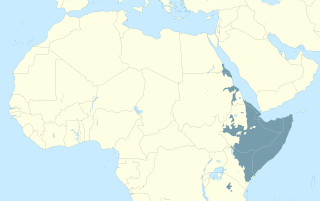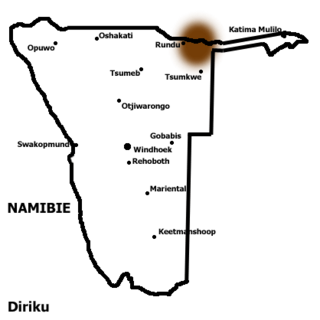Related Research Articles

The Cushitic languages are a branch of the Afroasiatic language family. They are spoken primarily in the Horn of Africa, with minorities speaking Cushitic languages to the north in Egypt and Sudan, and to the south in Kenya and Tanzania. As of 2012, the Cushitic languages with over one million speakers were Oromo, Somali, Beja, Afar, Hadiyya, Kambaata, and Sidama.
Masaba (Lumasaaba), sometimes known as Gisu (Lugisu) after one of its dialects, is a Bantu language spoken by more than two million people in East Africa. The Gisu dialect in eastern Uganda is mutually intelligible with Bukusu, spoken by ethnic Luhya in western Kenya. Masaba is the local name of Mount Elgon and the name of the son of the ancestor of the Gisu tribe. Like other Bantu languages, Lumasaba nouns are divided into several sets of noun classes. These are similar to the genders in Germanic and Romance languages, except that instead of the usual two or three, there are around eighteen different noun classes. The language has a quite complex verb morphology.

Herero (Otjiherero) is a Bantu language spoken by the Herero and Mbanderu peoples in Namibia and Botswana, as well as by small communities of people in southwestern Angola. There were 250,000 speakers in these countries between 2015 and 2018.
The South Cushitic or Rift languages of Tanzania are a branch of the Cushitic languages. The most numerous is Iraqw, with half a million speakers. Scholars believe that these languages were spoken by Southern Cushitic agro-pastoralists from Ethiopia, who began migrating southward into the Great Rift Valley in the third millennium BC.
Luhya is a Bantu language of western Kenya.
Kenya is a multilingual country. The two official languages of Kenya, Swahili and English, are widely spoken as lingua francas; however, including second-language speakers, Swahili is more widely spoken than English. Swahili is a Bantu language native to East Africa and English is inherited from British colonial rule.
Sonjo, or Temi, is a Bantu language spoken in northern Tanzania, 30–40 miles (48–64 km) west of Lake Natron. Ethnolinguistically, it is a displaced member of Guthrie’s E50 group, most other members of which are found in Central Kenya. Within that group, it is most closely related to Gikuyu. The Sonjo people number about 30,000 ; many of them are bilingual in Swahili, the local language of education. Sonjo is largely undescribed.
Gweno is a Bantu language spoken in the North Pare Mountains in the Kilimanjaro Region of Tanzania. The people known as the Gweno are a Chaga ethnic and linguistic group. Since the Chaga people are Bantu speakers, the adopted language contains dialects similar to that of the Kenyan language Kamba. Gweno shares about 54% to 56% of its vocabulary with other Chaga dialects and 46% with Taita dialects. However, a large percentage of its vocabulary is not seen in the other dialects. Also at the start of the 11th century, the Chaga people descended and migrated from the Bantu group in which they migrated to the foothills of mount Kilimanjaro. The Gweno language is today spoken mostly by older adults, with younger generations having shifted to Asu and Swahili. Ethnologue considers Gweno to be moribund; the language is not being passed down because children have not been exposed to Gweno since the 1970s. The generational shift from Gweno to either Asu or Swahili has certainly created shifts in dialect, however Gweno speakers do not see this as a threat.
Bravanese, also called Chimwiini or Chimbalazi, is a Bantu language related to Swahili spoken by the Bravanese people, who are the predominant inhabitants of Barawa or Brava, in Somalia. Maho (2009) considers it a distinct dialect, and it has been classified as a Northern Dialect of Swahili. However, it strongly distinguishes itself from standard Swahili under all linguistic considerations.
Pare (Kipare), also known as Asu, is a Northeast Coast Bantu language spoken by the Pare people of Tanzania.

Gciriku, or Dciriku, is a Bantu language spoken by 305,000 people along the Kavango River in Namibia, Botswana and Angola. 24,000 people speak Gciriku in Angola, according to Ethnologue. It was first known in the west via the Vagciriku, who had migrated from the main Vamanyo area and spoke Rugciriku, a dialect of Rumanyo. The name Gciriku remains common in the literature, but within Namibia the name Rumanyo has been revived. The Mbogedu dialect is extinct; Maho (2009) lists it as a distinct language, and notes that the names 'Manyo' and 'Rumanyo' are inappropriate for it.
Maʼa is a Bantu language of Tanzania.
Chopi,, is a Bantu language spoken along the southern coast of Mozambique.
Mijikenda is a Bantu dialect cluster spoken along the coast of East Africa, mostly in Kenya, where there are 2.6 million speakers but also in Tanzania, where there are 166,000 speakers. The name Mijikenda means "the nine settlements" or "the nine communities" and refers to the multiple language communities that make up the group. An older, derogatory term for the group is Nyika which refers to the "dry and bushy country" along the coast.
Kuria is a Bantu language spoken by the Kuria people of Northern Tanzania, with some speakers also residing in Kenya.
Kuvale is a Southern Bantu language spoken in Angola, in the middle of a large Umbundu-speaking area. It has traditionally been considered a dialect of Herero; however, Maho (2009) has moved it from Bantu Zone R.30 to Zone R.10, which includes Umbundu and a few smaller languages. Ngendelengo may be a distinct language.
Kaalong (Kàlòng) also known as Dimbong (Mbong), is an almost extinct Bantu language from the Center Province of Southern Cameroon.
Sagara (Sagala) is a Bantu language of the Morogoro and Dodoma regions of Tanzania. It is sometimes called Southern Sagala to distinguish it from the Sagalla language of Kenya ; the similarity of the names is a coincidence.
Taita Cushitic is an extinct pair of South Cushitic languages, spoken by Cushitic peoples inhabiting the Taita Hills of Kenya, before they were assimilated into the Bantu population after the Bantu Migration into East Africa. Evidence for the languages is primarily South Cushitic loanwords in the Bantu languages Dawida and Saghala, as well as oral traditions of the Dawida and Saghala.

The boundaries of this corridor can be defined within the Maasai territory. The corridor stretches from the Arusha Region, through the Kilimanjaro Region of Tanzania to the Taita-Taveta County of Kenya. To varying degrees, the people in this corridor are essentially a mixture of similar Bantu, Nilotic and Cushitic branches of the African people. The groups were dynamic, fluid and flexible. They shared a common history characterised by constant movement between the different areas for trade, battles, migration as well as social reasons. They were categorised arbitrarily by Europeans into the following culturally, linguistically and/or genetically related groups:
References
- ↑ Taita at Ethnologue (21st ed., 2018)

Sagala at Ethnologue (21st ed., 2018)
- 1 2 Jouni Filip Maho, 2009. New Updated Guthrie List Online
- ↑ Sommer, Gabriele (1992). "A survey of language death in Africa". In Brenzinger, Matthias (ed.). Language Death: Factual and Theoretical Explorations with Special Reference. Walter de Gruyter. pp. 392–394. ISBN 3110870606.
- ↑ Nurse, Derek (1988). "Extinct Southern Cushitic Communities in East Africa". In Bechhaus-Gerst, Marianne; Serzisko, Fritz (eds.). Cushitic-Omotic: Papers from the International Symposium on Cushitic and Omotic Languages, Cologne, January 6-9, 1986. Buske Verlag. p. 99. ISBN 3871188905.
- 1 2 Kioko, Angelina; et al. (2012). "A Unified Orthography for Bantu Languages of Kenya". Centre for Advanced Studies of African Society Monographs (249).